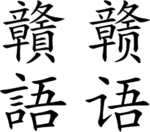Gan Chinese
| Gan | |
|---|---|
|
贛語/赣语 Gon ua |
|

Gan ua (Gan) written in Chinese characters
|
|
| Native to | China |
| Region | central and northern Jiangxi, eastern Hunan, eastern Hubei, southern Anhui, northwest Fujian |
| Ethnicity | Gan people (Han Chinese) |
|
Native speakers
|
22 million (2007) |
| Language codes | |
| ISO 639-3 | |
| Glottolog | ganc1239 |
| Linguasphere | 79-AAA-f |
 |
|
| Gan Chinese | |||||||||||||||
| Simplified Chinese | 赣语 | ||||||||||||||
|---|---|---|---|---|---|---|---|---|---|---|---|---|---|---|---|
| Traditional Chinese | 贛語 | ||||||||||||||
| Gan | Gon ua | ||||||||||||||
|
|||||||||||||||
| Jiangxi dialect | |||||||||||||||
| Simplified Chinese | 江西话 | ||||||||||||||
| Traditional Chinese | 江西話 | ||||||||||||||
| Gan | Kongsi ua | ||||||||||||||
|
|||||||||||||||
| Transcriptions | |
|---|---|
| Standard Mandarin | |
| Hanyu Pinyin | Gàn Huà |
| Gan | |
| Romanization | Gon ua |
| Hakka | |
| Romanization | Kàm-ngî |
| Transcriptions | |
|---|---|
| Standard Mandarin | |
| Hanyu Pinyin | Jiāngxī Huà |
| Gan | |
| Romanization | Kongsi ua |
Gan is a group of Chinese varieties spoken as the native language by many people in the Jiangxi province of China, as well as significant populations in surrounding regions such as Hunan, Hubei, Anhui, and Fujian. Gan is a member of the Sinitic languages of the Sino-Tibetan language family, and Hakka is the closest Chinese variety to Gan in terms of phonetics.
Different dialects of Gan exist; the Nanchang dialect is usually taken as representative.
Like all other varieties of Chinese, there is a large amount of mutual unintelligibility between Gan Chinese and other varieties. Within the variation of Chinese dialects, Gan has more similarities with Mandarin than with Yue or Min.
Most Gan speakers live in the middle and lower reaches of the Gan River, the drainage area of the Fu River, and the region of Poyang Lake. There are also many Gan speakers living in eastern Hunan, eastern Hubei, southern Anhui, northwest Fujian, etc.
According to the Diagram of Divisions in the People's Republic of China, Gan is spoken by approximately 48,000,000 people: 29,000,000 in Jiangxi, 4,500,000 in Anhui, 5,300,000 in Hubei, 9,000,000 in Hunan, and 270,000 in Fujian.
During the Qin Dynasty (221 BC), a large number of troops were sent to southern China in order to conquer the Baiyue territories in Fujian and Guangdong, as a result, numerous Han Chinese emigrated to Jiangxi in the years following. In the early years of the Han Dynasty (202 BC), Nanchang was established as the capital of the Yuzhang Commandery (豫章郡) (this name stems from the original name of Gan River), along with the 18 counties (縣) of Jiangxi Province. The population of the Yuzhang Commandery increased to 1,670,000 (by AD 140) from 350,000 (in AD 2), with a net growth of 1,320,000. The Yuzhang Commandery ranked fourth in population among the more than 100 contemporary commanderies of China. As the largest commandery of Yangzhou, Yuzhang accounted for two fifths of the population and Gan gradually took shape during this period.
...
Wikipedia
